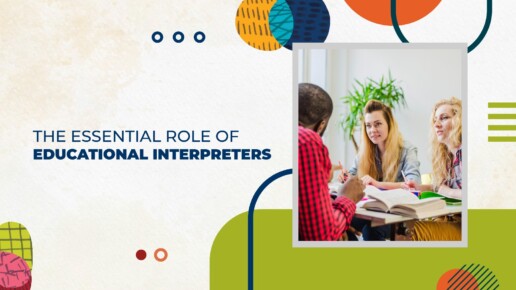The Essential Role of Educational Interpreters
The importance of communication across languages has never been more crucial. Education is one of the primary areas where language barriers can significantly impact students. That’s where educational interpreters come in. These professionals ensure that every student, regardless of their native language, receives equal access to educational opportunities. But what exactly do they do, and why are they so vital to our educational systems?
What Is an Educational Interpreter?
An educational interpreter is a professional who facilitates communication between students who are non-native speakers of the dominant language and their teachers, peers, or educational staff. These interpreters services can work in various educational settings, from K-12 schools to universities. Their primary role is to ensure that students who face language barriers can fully participate in classroom activities and understand the instructional content provided by teachers.
Why Are Educational Interpreters Important?
Educational interpreters play a pivotal role in making education more inclusive. For many students, language is a barrier to understanding the curriculum, engaging in classroom discussions, and even participating in extracurricular activities. Without educational interpreters, these students might struggle to keep up with their peers, leading to a less fulfilling academic experience and potentially lower achievement levels.
By breaking down language barriers, interpreters:
- Ensure equal access to education.
- Help students develop a sense of belonging in their school environment.
- Foster better communication between students, teachers, and families.
The Scope of Responsibilities of Educational Interpreters
Contrary to popular belief, educational interpreters do much more than merely translate words. Their tasks are multifaceted and can include:
- Facilitating Classroom Communication
The primary role of an educational interpreter is to act as a bridge of communication between the teacher and the student. This includes translating lectures, instructions, classroom discussions, and even informal conversations between peers.
- Enhancing Academic Participation
Interpreters don’t just translate words, they ensure that the student understands the nuances of the curriculum. This often involves simplifying complex terminology or explaining cultural references to ensure the student can follow the lesson fully.
- Providing Cultural Context
In addition to language, educational interpreters often offer cultural interpretation. This means helping students and teachers navigate cultural differences that could affect understanding or behavior in the classroom.
- Supporting Teachers in Delivering Instruction
Teachers may need assistance in adjusting their teaching methods to suit the needs of a student with language barriers. Educational interpreters can offer insights on how to modify lesson plans or activities to make them more accessible.
- Facilitating Parent-Teacher Conferences
Educational interpreters also play a crucial role in parent-teacher communication. They ensure that non-English-speaking parents are fully informed about their child’s academic progress, behavior, and any issues that may arise.
Different Types of Educational Interpreters
There are various types of educational interpreters, each specializing in different modes of communication:
- Language Interpreters
These professionals assist students who speak a different spoken language than the one used for instruction. For example, an interpreter may assist a Spanish-speaking student in an English-only classroom.
- Sign Language Interpreters
Sign language interpreter school work with students who are deaf or hard of hearing, translating spoken language into sign language. This type of interpretation requires specialized training in sign language, such as American Sign Language (ASL).
- Bilingual Education Assistants
Bilingual education assistants may work alongside teachers, providing dual-language support for students who are learning in a bilingual or multilingual environment.
The Challenges Faced by Educational Interpreters
While educational interpreters play a vital role in the classroom, they also face several challenges:
- Maintaining Neutrality
Interpreters must remain neutral in their translations, ensuring that they don’t insert their own opinions or biases into the conversation.
- Navigating Educational Terminology
Educational settings often use specialized vocabulary or jargon that may not easily translate into other languages. Interpreters must stay up-to-date on educational terminology to provide accurate translations.
- Addressing Emotional Strain
The job can be emotionally taxing, especially when interpreters are helping students deal with difficult situations, such as misunderstandings, bullying, or academic struggles.
The Growing Demand for Educational Interpreters
With increasing immigration and growing linguistic diversity, the need for educational interpreters is rising. Schools are recognizing the importance of offering language support to ensure that all students, regardless of their linguistic background, have an equal opportunity to succeed. This growth is creating more job opportunities for skilled interpreters across various educational institutions.
How to Become an Educational Interpreter
For those interested in pursuing a career as an interpreter, here are the general steps:
- Obtain a Degree in Interpretation or a Related Field
Most educational interpreters have a degree in interpretation, translation, or a related field, such as linguistics or communication studies.
- Gain Experience in Educational Settings
Practical experience in schools or other educational environments is critical. Volunteering or internships can provide valuable hands-on experience.
- Obtain Certification
In some cases, obtaining certification from recognized professional bodies, such as the Registry of Interpreters for the Deaf (RID) for sign language interpreters, may be required or highly beneficial.
The Future of Educational Interpretation
As continues to become more inclusive, the demand will likely continue to grow. Technological advances, such as real-time translation tools, may supplement human interpreters but are unlikely to replace the need for skilled professionals who can navigate the nuances of language and culture.
Conclusion
In a world where diversity is ever-increasing, educational interpreters play a crucial role in ensuring that all students have access to a fair and inclusive education. By bridging language gaps, they help create a learning environment where every student can thrive, regardless of their linguistic background. The work is not only about translation, it’s about fostering understanding, breaking down barriers, and contributing to the success of students from all walks of life.

